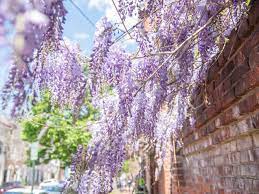 We are well into mid-spring and everything has burst into bloom. In my corner of the northeastern United States, you can drive down local streets and highways and see redbuds finishing their run of bloom as dogwoods get going. If you are lucky, you might also see a silverbell tree—Halesia Carolina—covered with hundreds of dangling white “bells”, and abuzz with pollinators.
We are well into mid-spring and everything has burst into bloom. In my corner of the northeastern United States, you can drive down local streets and highways and see redbuds finishing their run of bloom as dogwoods get going. If you are lucky, you might also see a silverbell tree—Halesia Carolina—covered with hundreds of dangling white “bells”, and abuzz with pollinators.
Plant lovers will also see vast quantities of showy, purple-flowered wisteria vines and paulownia trees. Both bloom in similar lavender shades, and because naturalized wisteria tends to clamber up trees, it is sometimes hard to tell the two apart.
The reason that both paulownia, known botanically as Paulownia tomentosa, and wisteria are so ubiquitous in some regions is because they share a singular trait—vigor to the point of invasiveness. That vigor is the result of both natural processes and the helping hand of man. The evolutionary process has provided the two species with fast growth rates. Man has helped out by transporting the plants to places far from the environments in which they evolved, resulting in extremely favorable conditions that lead to rapid growth and contribute to a high seed germination rate.
“Some plants are so tough they can grow on damp linoleum,” my botanist aunt used to say. Paulownia and wisteria fit that description.
Both species are glorious in bloom. Asian wisteria, either the Chinese Wisteria chinensis or its near look-alike, Japanese Wisteria floribunda, cover themselves with large, drooping flower clusters or racemes of lusciously fragrant blooms. If you have seen ornamental sweet peas flowers, you will have an idea of the appearance of individual wisteria blossoms.
Paulownia flowers, by contrast, look a lot like foxgloves—large, fragrant purple “fingers” freckled with darker purple and accented with yellow throats. They grow in fat, upright clusters, but do not droop like wisteria racemes.
The trees came from China in the nineteenth century and probably escaped domestic cultivation almost immediately. Now, in USDA plant hardiness zones five through eight, they have often naturalized themselves in untended woodland edges, areas bordering parks, and on railroad rights-of-way. If you spot one paulownia, there are probably others nearby. When not flowering, you can recognize paulownia trees by their large, heart-shaped leaves.
Wisteria is a climber that also originated in China, and conquered the rest of the gardening world with its gorgeous looks and climbing stems that can rise 25 feet or more. Those stems, adorned with lacey compound leaves, can scale trees, buildings, power poles and any other handy vertical structure. Older specimens develop gnarled, tree-like trunks, and the mature weight of vigorous wisteria vine can topple a less than robust building or tree.
Every species has plusses and minuses. Paulownia and wisteria are pollinator magnets and will tolerate drought and poor soil. They provide valuable habitat for birds and small animals. Paulownia is sometimes classified as a “pioneer species”, because it has the hardiness and adaptability to be among the first plants to colonize barren or disturbed environments.
The chief “minus” of both species is invasiveness. Rampaging over landscapes in the eastern half of North America, wisteria and paulownia outcompete other species, including vulnerable native plants.
What plants should you grow instead? Native American wisteria or Wisteria frutescens, offers the same fragrant purple blooms and climbing habit, but does not have the invasive tendencies of its non-indigenous relations.
If you seek a flowering tree with the beauty and impact of paulownia, try northern or southern catalpa–Catalpa speciosa or Catalpa bignonioides. Both bear “candles” or upright flower spikes composed of scores of ruffled white blooms, accented with yellow throats and narrow, dark purple striping. Granted, the flowers are not vivid lavender, but they are gorgeous and attract lots of pollinators. Catalpas also have lovely heart-shaped leaves and impressive bean-like seed pods. Like paulownias, the trees grow to impressive heights, and can be somewhat invasive. Their native status probably gives them a bit of an edge over paulownia in the desirability sweepstakes.
So…appreciate the paulownias and wisteria when you see them, but plant alternatives when you have the chance. Aiming for better environmental stewardship is always a good idea.
